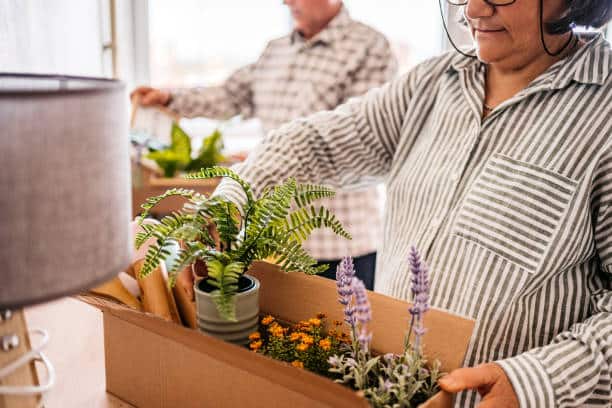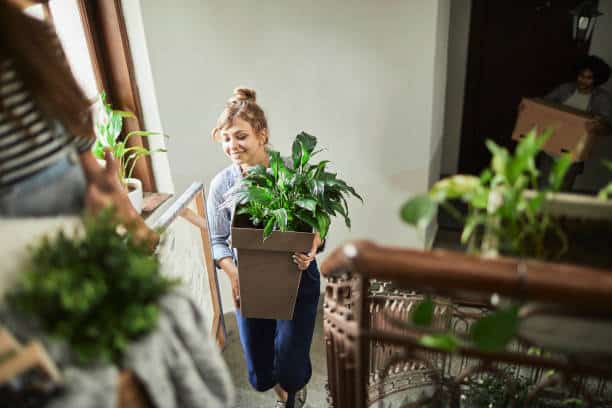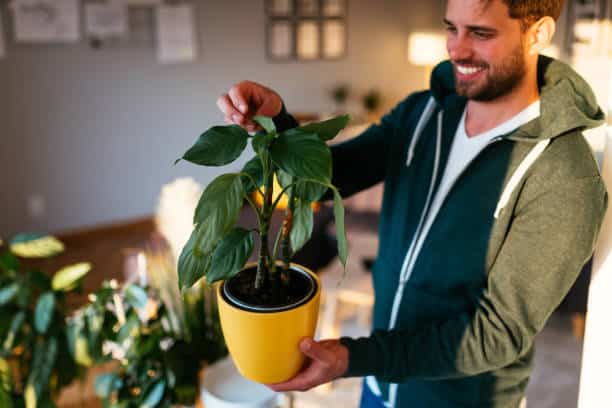How to pack plants effectively for moving
Get Your Free Moving Estimate
How to pack plants for moving like movers in Texas
Moving plants is stressful for both the plants and their owners. Plants prefer to remain in a home where they are comfortable. Meanwhile, moving means rearranging furniture, taking down curtains, packing up the entire house… and this can be rather traumatic for plant owners as well. It is possible to successfully move houseplants, however, it takes some extra care and extra time on your part. Luckily, there are many local movers from east Texas to West Texas that can provide you with the best moving services that any plant parent would appreciate.
What to prepare when packing plants
- Moving boxes (cardboard, stacking type)
- Packing paper (to wrap around plants)
- Newspaper (to line the box/wrap individual plants)
- Sharp knife (X-acto / craft knife, etc.) or box cutter
- Tape measure
- Ruler
- Pencil
- Protective gloves

How to pack plants effectively for moving to major cities or suburbs
Determine the size and number of plants you have.
Some people have a day or two to spare between packing up their old home and moving into the new one. Others have only a couple of hours before having to move themselves in. In general, it is much easier to transport smaller potted plants than larger ones due to weight limits and where potting materials settle inside each container.
However, with the help of moving companies, you can be assured that your plants will be in good hands.
Estimate how long it takes to pack.
When it comes to moving, a large number of house plants is a nightmare for movers and a potential deathtrap for plants! A simple way to measure how many days there are between packing and unpacking is counting “plant” days. For every human day that passes, add one plant day. If you live in a house with two people and everyone has to move into a new home on the same day, then it is 2 days between packing up your old home and moving into your new one. Add 2 plant days for this.
If you have only 1-2 days to pack before moving, aim for just one larger container per person who will be helping you move. There are some tall plants which can easily be cut back so they fit where space is limited. The shorter the plant, the more likely it is to survive being moved successfully because its roots won’t be disturbed as much.

Discard unhealthy plants.
Leave any plant which looks sick or unhealthy. It will be too much work trying to nurse an already wilting or struggling plant back to good health. If it looks like the only thing that could bring the plant back would be soil (and lots of it), then consider whether your new home has adequate drainage for this type of pottery container. For example, very few kitchens do not include underfloor channels running cupboards. If you decide to move one of these plants to your kitchen, don’t be surprised if it rots and dies.
Consider how much soil there is left in the pot or storage unit.
Dried out roots will make transplanting difficult. If you can see any sign of root health (brown rather than white), remove as much soil as possible and place it into a temporary storage unit such as a pot or brown paper bag.
If not, and you decide to move the plant anyway, then firstly cut back all dead foliage and cut off any damaged branches before attempting to remove any remaining soil . The less dirt that falls out on the floor, the better!
Before moving day arrives, put as much soil as possible into a brown paper bag or plastic container so you can transport it with your plant. You can add more later when the plant is in its new location and watered again.
Take notice of stones and rocks.
These will likely fall out on moving day; hopefully they won’t cause too much of a hazard, but obviously place these somewhere where they won’t roll into someone’s foot!
Keep records of where each plant was originally situated in your home.
If you have time, make a sketch of the plant pot and add measurements if possible to help other people identify exactly what it is without having to remove soil from the dirt. If not, take photos instead.

Check the car or moving truck.
Check the pot if it will fit into your car or the mover’s truck without spilling soil everywhere or damaging passenger seats with hanging foliage. If it doesn’t, then try dismantling it so it becomes a smaller package.
However, remember to keep all parts together if this way works for you. There are plants which cannot be separated from their pots because their roots have grown into the holes at the bottom. You may have to leave them behind unless there’s space for one per person who will be helping you move.
Water them.
Remember to water all potted plants well before you plan to transport them (if they’re too dry then you risk shrinkage due to transpiration). This will reduce the amount of stress placed upon them during transport.
If you over-water young plants, then you risk encouraging fungal or bacterial rot. Moving services companies will also ask you to just keep the plants moist during transport.
After unloading the plants from containers
Arrange in their original positions if possible.
Once you arrive at your new abode, try to place plants in their original locations if at all possible. This is because they will already be familiar with the light and humidity conditions. If not practical, try to identify a similarly suitable position for each.
If you cannot establish its precise sun requirements (and even if you can), be sure to give it some shade from mid-afternoon onward. Do this unless you want fried foliage! It is particularly important in hot climates but applies everywhere really.
Consider sunlight.
You should have some idea about the new lighting conditions in your abode. This isn’t too important for most foliage plants but it is one of the first things to examine if you wish to keep any flowers alive. If possible, also try to get hold of a hygrometer before moving day so you can establish how wet the air is because this will help prevent many fungal diseases from taking hold too.

Keep them apart.
If there are no drainage channels below where placing pots, consider whether adequate space has been left around them so they won’t over-water other items such as cables and shoes. Additionally, try not to place them too close together so they prevent airflow between each other; this will help deter the spread of fungal diseases and also stop any leaves from touching wet soil which can lead to rot.
Find an alternative spot.
If you cannot transfer all your plants (for whatever reason), find somewhere else to keep them such as a rented garage or garden shed; if you’ve had to take out repossession orders then it may be your only choice. Be sure that whatever place you choose has good air circulation and will not become too cold or hot at any time. Both dryness and frost can cause irreversible damage to foliage.
If the plants cannot stay outside because of their current location (for example, if there is no garden or balcony), try to find where they would live best in your new home before moving day. If you can draw up a diagram on paper, include notes about how much sunlight each receives where they are now. It’s particularly important to do this for tropicals as they cannot acclimate as easily as hardy species such as begonias and chrysanthemums.
More tips when packing plants for moving
- If the plants do not have drainage holes, consider getting another container or having their roots exposed during transit to avoid root rot.
- You will need larger boxes for taller plants so they stay upright during the move.
- Knowing the dimensions of your plants will help you estimate how many can fit into a box. It will also estimate how many boxes are needed.
- Try to group similar-sized plants together by twos or threes if possible so they don’t shift around too much inside the box while being moved.
- Packing paper is fairly cheap and very easy to use. Cut a few sheets into flat pieces that can be wrapped around individual plants and secured with tape. A lot of paper will be required, so expect this step alone to take some time.
- Newspaper is great for cushioning your plants on top of one another but you must take care not to damage delicate roots when doing so.
- A sharp knife will make the process of cutting newspaper easier for large batches. If you are using several sheets at once rather than cutting it into smaller pieces first before use.

Finding a trusted moving team
Whether you’re in West Texas, Central Texas or in other major cities such Austin, TX or San Antonio, you can always contact a moving company to get your plants prepared for transport. They do an amazing job at providing you with storage units and packing supplies for your precious plants. If you check online, services range from moving to even offering a self-storage facility for your other items (sports equipment, furniture, etc.) during the move.
Be sure to ask for a free quote or free estimates of the cost of your moving needs. You may even get discounts if you also avail of their storage facilities and climate-controlled units.
When Texas gained hundreds of local movers, so many customers started having plenty of options for moving services. But not everyone does an amazing job when it comes to moving.

Frequently Asked Questions about packing plants effectively for moving
Why is it stressful to move plants?
Moving plants is stressful for both the plants and their owners. Plants are living things, so they want to remain in a home where they are comfortable. Meanwhile, moving means rearranging furniture, taking down curtains, packing up the entire house…and this can be rather traumatic for plant-owners as well.
Why do plants need special attention while moving?
Houseplants are most likely not the only things you will have to move when you relocate to our from the Austin area, for example. Therefore, it is important that they be packed properly. Avoid damaging them due to other objects pressing on the stems or against the foliage.
How can I best place houseplants in my new home?
After you’ve moved, remember to keep newly potted or re-potted plants in half shade for up to a few months. This will keep the branches protected from too much exposure to sunlight. Otherwise, it can fade or stain their bark almost immediately during their transplant shock stage.
What should I do if the plant’s soil gets dislodged during transport to Central Texas or other areas?
If any soil is dislodged, then carefully remove it without touching the root ball with your bare hands. Do this after unpacking but before moving plants up into more light intensity.
What should I consider before deciding to move my plants to far places such as San Antonio?
The first step is having a plan before you start moving. It should include a list of every plant that will be moved (with estimated weights), an assessment of how many movers you have available, and the number of days between when you pack your plants and when you move them into your new house.
—
Enjoy a streamlined relocation with expert moving teams no matter where you live with Heavenly Moving and Storage. Book your move knowing you have the full support of the only moving company in Austin on ABJ’s 2021 Best Places to Work and Best of the Best Moving Company Finalist. Get your free quote today or call us at 512-340-0551.
